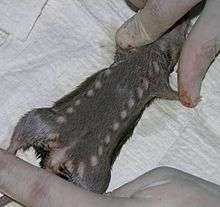Natal multimammate mouse
The Natal multimammate mouse (Mastomys natalensis) is a species of rodent in the family Muridae. It is also known as the Natal multimammate rat, the common African rat, or the African soft-furred mouse.[1]
| Natal multimammate mouse | |
|---|---|
 | |
| Scientific classification | |
| Kingdom: | Animalia |
| Phylum: | Chordata |
| Class: | Mammalia |
| Order: | Rodentia |
| Family: | Muridae |
| Genus: | Mastomys |
| Species: | M. natalensis |
| Binomial name | |
| Mastomys natalensis Smith, 1834 | |
| Synonyms | |
| |
Range
It is found in Africa south of the Sahara, that is in Angola, Benin, Botswana, Burkina Faso, Burundi, Cameroon, the Central African Republic, Chad, the Republic of the Congo, the Democratic Republic of the Congo, Ivory Coast, Equatorial Guinea, Ethiopia, Gabon, Ghana, Guinea, Guinea-Bissau, Kenya, Lesotho, Malawi, Mali, Mauritania, Mozambique, Namibia, Niger, Nigeria, Rwanda, Senegal, Sierra Leone, Somalia, South Africa, Sudan, Eswatini, Tanzania, Togo, Uganda, Zambia, and Zimbabwe. Six different genetic groups can be distinguished in different regions: one in western Africa, one in central Africa, one in southern Africa and three in eastern Africa[2].

Habitat
Its natural habitats are subtropical or tropical dry forest, subtropical or tropical moist lowland forest, dry savanna, moist savanna, subtropical or tropical dry shrubland, subtropical or tropical moist shrubland, arable land, pastureland, rural gardens, urban areas, irrigated land, and seasonally flooded agricultural land.
These rats associate closely with humans, and are commonly found in and around African villages.
In 1972, the Natal multimammate rat was found to be the natural host of the Lassa fever virus.
Interactions with humans
The species has been used as a laboratory animal since 1939. It has great value for researchers who focused on stomach cancer and spontaneous tumors. It is also the most important reservoir of Lassa virus.[3]
References
- "Archived copy". Archived from the original on 2009-02-07. Retrieved 2009-07-14.CS1 maint: archived copy as title (link)
- Colangelo, Paolo (2013). "A mitochondrial phylogeographic scenario for the most widespread African rodent, Mastomys natalensis". Biological Journal of the Linnean Society. 108 (4): 901–916. doi:10.1111/bij.12013.
- Clive Roots; Domestication - page: 115
- Granjon, L., Lavrenchenko, L., Corti, M., Coetzee, N. & Rahman, E.A. 2004. Mastomys natalensis. 2006 IUCN Red List of Threatened Species. Downloaded on 9 July 2007.
- Musser, G.G.; Carleton, M.D. (2005). "Superfamily Muroidea". In Wilson, D.E.; Reeder, D.M (eds.). Mammal Species of the World: A Taxonomic and Geographic Reference (3rd ed.). Johns Hopkins University Press. p. 1365. ISBN 978-0-8018-8221-0. OCLC 62265494.
- Tofts, Russell. Multimammate Mice. Retrieved July 14, 2009.
